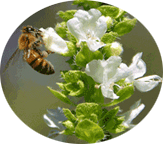Lard from Pork Fat—Rendering Lard
Contributed by Lisa, who is a member of Bee’s Candida Support Group, that you are welcome to join!
Makes about 9 cups of lard.
Rendering is the process for separating fats from other organic materials. When fat is rendered it is heated until it is melted (made liquid).
Lard can be obtained from any part of the pig as long as there is a high concentration of fatty tissue. The highest grade of lard, known as leaf lard, is obtained from the "flare" the fat deposits surrounding the kidneys and inside the loin. The next highest grade of lard is obtained from fatback, the hard subcutaneous fat between the back skin and muscle of the pig. The lowest grade (for purposes of rendering into lard) is obtained from the soft fat surrounding digestive organs, called caul fat, such as small intestines, although caul fat is often used directly as a wrapping for roasting lean meats.
Ingredients & Supplies
- 5 pounds of pork back fat
- large pot for melting the fat
- large strainer
- cheesecloth
- containers with covers for storing the lard, preferably glass, or brown butcher’s paper waxed on one side for wrapping up the lard
Preparation
- Chop up the fat into small squares. The more it is chopped up the quicker it will melt down, which is called rendering. 1 inch by 1 inch squares is okay.
- Put the fat in a large pot, and add water to about half the volume of the fat—do not add too much water since it will slow down the process. Do not cover the pot.
- Bring it to a slow boil over low heat, stirring frequently. The water moderates the temperature so the fat does not burn or stick to the pot. Eventually, the water will evaporate, leaving a golden liquid which is only melted fat. You’ll know when this happens because the bubbles will look different. Keep cooking until the solid fat has totally melted.
- Stir it occasionally to mash up the fat bits, and skim off all of the foamy scum as it rises to the surface.
- Once the fat is completely melted there should not be any water left in it. Turn off the heat and carefully pour the liquid fat through a cheesecloth-lined strainer into a large container.
- Let the fat cool until it is just warm and still liquid, and add a lot of water to it. This gets rid of some of the little protein bits in the fat. Put it in the refrigerator overnight.
- The next morning there will be a thick slab of lard sitting on top of the water. Remove the lard slab and dry it thoroughly.
- Chop the lard into pieces. You can either wrap the lard in butcher’s brown paper, or melt it over low heat and ladle the liquid fat into containers with covers.
- It can be stored in the refrigerator or frozen.
